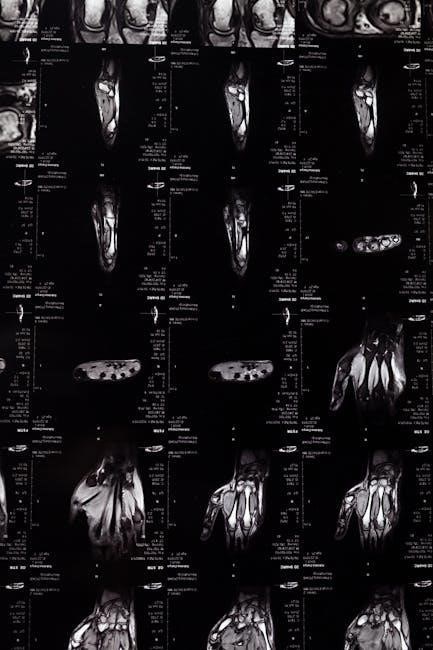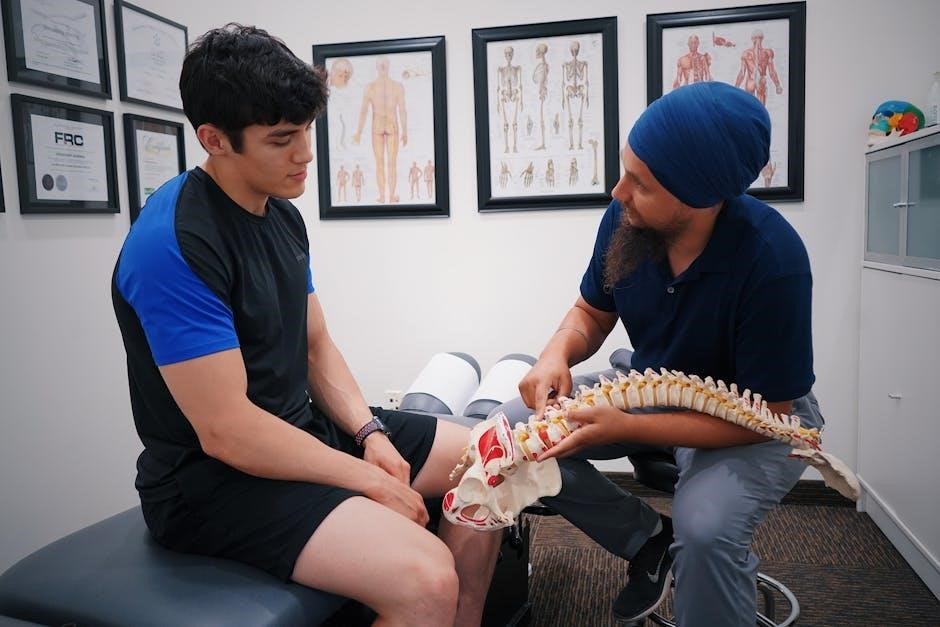Musculoskeletal examination is crucial for assessing the musculoskeletal system, including joints and muscles, using various techniques and methods to evaluate function and identify disorders accurately always online.
Importance of Musculoskeletal Examination
Musculoskeletal examination is essential for diagnosing and managing musculoskeletal disorders, which are common causes of disability and pain, affecting millions of people worldwide, with a significant impact on quality of life and healthcare costs. The examination helps clinicians to identify the underlying cause of symptoms, such as pain, swelling, and limited mobility, and to develop an effective treatment plan. According to various studies, including those published in Arthritis Care and Research, musculoskeletal disorders are a leading cause of disability, and early diagnosis and treatment can significantly improve outcomes. By integrating findings from physical examination with patient history and diagnostic imaging, clinicians can formulate precise diagnoses and develop targeted treatment strategies to improve patient outcomes and reduce healthcare costs, making musculoskeletal examination a crucial component of healthcare services, with a focus on prevention, diagnosis, and management of musculoskeletal disorders.
Scope of Musculoskeletal Examination
The scope of musculoskeletal examination encompasses a comprehensive assessment of the musculoskeletal system, including joints, muscles, bones, and related structures, to evaluate function, identify disorders, and develop treatment plans. This examination involves a thorough evaluation of the patient’s medical history, physical condition, and lifestyle, as well as a physical assessment of the musculoskeletal system, using techniques such as inspection, palpation, and range of motion testing. According to various medical sources, including the American College of Rheumatology, the scope of musculoskeletal examination also includes the evaluation of systemic diseases that affect the musculoskeletal system, such as rheumatoid arthritis and osteoporosis, and the assessment of functional abilities, such as mobility and daily activities, to provide a comprehensive understanding of the patient’s condition and develop an effective treatment plan, with a focus on improving patient outcomes and quality of life, and reducing disability and pain.

Techniques of Musculoskeletal Examination
Musculoskeletal examination techniques include inspection and palpation methods using various approaches always online effectively.
Inspection Technique
The inspection technique is a crucial part of the musculoskeletal examination, allowing clinicians to visually assess the patient’s musculoskeletal system. This involves observing the size and contour of each joint, as well as the skin over each joint for any signs of color change, swelling, or masses. The clinician should also note any deformities or abnormalities, such as contractures or misalignments. By using this technique, clinicians can gather valuable information about the patient’s condition and identify potential areas of concern. The inspection technique is often used in conjunction with other examination methods, such as palpation and range of motion testing, to provide a comprehensive assessment of the musculoskeletal system. This approach enables clinicians to develop an accurate diagnosis and create an effective treatment plan for the patient. Musculoskeletal examination techniques are widely used in medical practice.
Palpation Technique
The palpation technique is a hands-on method used to assess the musculoskeletal system, involving the use of fingertips to feel and examine the patient’s joints, muscles, and surrounding tissues. This technique allows clinicians to detect any abnormalities, such as swelling, tenderness, or warmth, and to assess the range of motion and joint stability. By applying gentle pressure, clinicians can also evaluate the texture and consistency of the tissues, helping to identify any potential problems. The palpation technique is an essential part of the musculoskeletal examination, providing valuable information about the patient’s condition and helping to guide further testing and treatment. Clinicians use this technique to gather information about the patient’s musculoskeletal system, and it is often used in conjunction with other examination methods to provide a comprehensive assessment. This approach enables clinicians to develop an accurate diagnosis.

Preparation for Musculoskeletal Examination
Preparation involves creating a comfortable environment using appropriate equipment and ensuring patient privacy always online securely.
Patient Preparation
Patient preparation is essential for a successful musculoskeletal examination, the patient should remove all but underclothing and wear a gown to allow for easy access to the joints and muscles. The patient should be informed about the examination procedure and what to expect, this helps to reduce anxiety and makes the patient more cooperative. A woman may tuck the gown into the top of her bra to maintain modesty, the patient should be positioned comfortably to allow for easy examination of the musculoskeletal system. The examiner should also ensure that the patient is warm and comfortable throughout the examination, this can be achieved by using a warm and quiet room. By following these steps, the patient will be well-prepared for the musculoskeletal examination, and the examiner will be able to obtain accurate and reliable results. The patient’s privacy should be respected at all times.
Examiner Preparation
The examiner should be well-prepared before performing a musculoskeletal examination, this includes having a good understanding of the musculoskeletal system and its functions. The examiner should also be familiar with the various examination techniques and methods, including inspection and palpation. A thorough review of the patient’s medical history and any relevant diagnostic images should be conducted before the examination. The examiner should also ensure that they have all the necessary equipment and tools, such as a stethoscope and a reflex hammer. By being well-prepared, the examiner will be able to conduct a thorough and accurate examination, and provide a reliable diagnosis and treatment plan. The examiner’s preparation is crucial for a successful musculoskeletal examination, and helps to ensure that the patient receives the best possible care. The examiner should also wash their hands before starting the examination.

Musculoskeletal Examination Sequence
Examination sequence includes inspecting and palpating joints and muscles in a specific order to evaluate function and identify disorders accurately using various methods and techniques always online quickly.
Sequence of Examination
The sequence of examination is crucial for a thorough assessment of the musculoskeletal system, and it typically begins with the patient standing or sitting comfortably. The examiner then proceeds to inspect and palpate the joints and muscles in a specific order, starting from the proximal areas and moving distally. This sequence allows for a systematic evaluation of the musculoskeletal system, enabling the examiner to identify any abnormalities or disorders. The sequence of examination may vary depending on the patient’s condition and the examiner’s preferences, but it generally follows a standardized approach to ensure a comprehensive assessment. By following a consistent sequence, the examiner can ensure that all relevant areas are evaluated, and no important findings are missed, allowing for an accurate diagnosis and effective treatment plan to be developed. The sequence is typically outlined in a musculoskeletal examination guide or protocol.

Value of History and Physical in Musculoskeletal Examination
History and physical examination are essential components of musculoskeletal assessment, providing valuable diagnostic information always using online resources and medical guides quickly and accurately every time.
Importance of History in Musculoskeletal Examination
The history of the patient is a crucial aspect of the musculoskeletal examination, as it provides valuable information about the patient’s symptoms, medical history, and lifestyle. A thorough history can help identify potential causes of musculoskeletal disorders, such as injuries, infections, or autoimmune diseases. The patient’s history can also reveal important details about their occupation, physical activities, and previous treatments, which can inform the physical examination and diagnostic process. By taking a comprehensive history, healthcare professionals can develop a more accurate understanding of the patient’s condition and develop an effective treatment plan. This information can be obtained through online resources and medical guides, and is essential for providing high-quality patient care and achieving optimal outcomes in the management of musculoskeletal disorders, using various techniques and methods to evaluate function and identify disorders accurately always.
Importance of Physical Examination in Musculoskeletal Examination
A physical examination is a critical component of the musculoskeletal examination, as it allows healthcare professionals to assess the patient’s physical condition and identify any abnormalities; The physical examination involves a range of techniques, including inspection, palpation, and movement assessment, to evaluate the musculoskeletal system. By using these techniques, healthcare professionals can identify signs of musculoskeletal disorders, such as swelling, deformity, or limited mobility. The physical examination also provides an opportunity to assess the patient’s functional ability and identify any limitations or restrictions. This information is essential for developing an effective treatment plan and can be used in conjunction with other diagnostic tools, such as imaging studies, to provide a comprehensive understanding of the patient’s condition and develop a personalized treatment plan using various online resources and medical guides.

